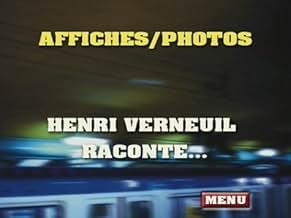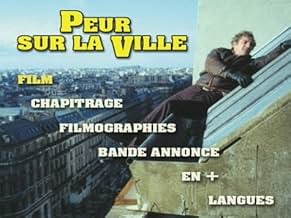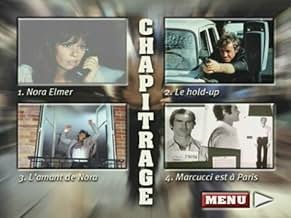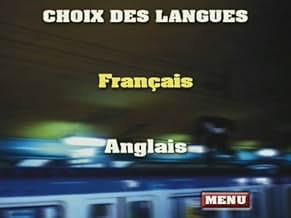Peur sur la ville
- 1975
- Tous publics
- 2h 5min
NOTE IMDb
6,9/10
4,7 k
MA NOTE
Le commissaire Letellier et l'inspecteur Moissac traquent Minos, un tueur de femmes en série.Le commissaire Letellier et l'inspecteur Moissac traquent Minos, un tueur de femmes en série.Le commissaire Letellier et l'inspecteur Moissac traquent Minos, un tueur de femmes en série.
- Réalisation
- Scénario
- Casting principal
Adalberto Maria Merli
- Pierre Valdeck
- (as Adalberto-Maria Merli)
- …
Avis à la une
What we have here is a crime thriller that includes most of the clichés of the genre, but does it in such a way that it feels original due to the execution. Henri Verneuil's film is really not what I was expecting it to be at all; it's actually a lot more than just a film about cops hunting a vicious psychopath and while not everything about the film works, what does work works brilliantly and this is certainly among the best European crime thrillers of the 1970's. The film is a French and Italian co-production, and while it's clear that the film is much more French than Italian; we still get some trademarks of Italian cinema thrown in and the film has elements of both the Polizi and Giallo genres. The plot simply focuses on an unknown serial killer that targets loose women in Paris by way of phone calls and later murder. Commissioner Jean Letellier and Inspector Moissac are put on the case and have to go through the Parisian underworld before coming close to catching the killer and discovering his insane reason for murdering the women of Paris.
The thing that really makes this film stand out is the leading performances courtesy of Jean-Paul Belmondo and Charles Denner. The pair fit into their roles excellently individually and have a great chemistry also, which director Henri Verneuil is keen to exploit as much as possible as the two actors provide the film with most of its best moments and also deliver some comedy. The film is not overly gory and the focus is never on the murders; although there are a few featured and the way that the director focuses on the killer's black gloves is a nice nod towards Giallo. The film features many of the crime film staples such as car chases and shootouts; a sequence that sees the main protagonist chase the killer in the middle of the film is excellently staged and very thrilling. The film changes pace many times throughout but the director always manages to keep things interesting. Adalberto Maria Merli's portrayal of the villain is suitably demented and detestable and the way that the film boils down towards the conclusion is well done and completely unexpected. Overall, this is an excellent film that doesn't deserve to be forgotten about and therefore comes highly recommended!
The thing that really makes this film stand out is the leading performances courtesy of Jean-Paul Belmondo and Charles Denner. The pair fit into their roles excellently individually and have a great chemistry also, which director Henri Verneuil is keen to exploit as much as possible as the two actors provide the film with most of its best moments and also deliver some comedy. The film is not overly gory and the focus is never on the murders; although there are a few featured and the way that the director focuses on the killer's black gloves is a nice nod towards Giallo. The film features many of the crime film staples such as car chases and shootouts; a sequence that sees the main protagonist chase the killer in the middle of the film is excellently staged and very thrilling. The film changes pace many times throughout but the director always manages to keep things interesting. Adalberto Maria Merli's portrayal of the villain is suitably demented and detestable and the way that the film boils down towards the conclusion is well done and completely unexpected. Overall, this is an excellent film that doesn't deserve to be forgotten about and therefore comes highly recommended!
Jean Paul Belmondo and his associate, Charles Denner, play tough cops after two killers in "Fear Over the City." Although not listed in the credits, the city of Paris plays a major supporting role. One killer, Marcucci, is a bank robber Belmondo's character is after for killing a fellow cop during an auto chase. At one point later in the picture, Belmondo is on the roof of a Paris Metro car above ground as it goes though Paris, with the cop killer inside the train. The viewer gets a chance to see the city sights as the train zips along.
The second killer, who uses the name "Minos," wants to rid the world of sexual immorality by targeting women he finds objectionable. Belmondo gets into a gunfight with Minos while on the sloping roof of a store, apparently the Galleries Lafayette. Director Verneuil does a great job of adding thrills as Belmondo slips on the sloping roof several times, almost falling off, all the while shooting it out with Minos. The pursuit of Minos after the roof fight leads to a chase through Paris, past the Eiffel Tower and through downtown streets, Belmondo's police car after Minos, on a motorcycle.
In this movie Belmondo gets a chance to play a real tough cop, one who shoots back at a suspect, hitting him, and then ignores him as he asks for an ambulance. Instead, Belmondo takes a break, reading a magazine in the wounded man's apartment until the guy talks. There is that scene in the basement of a bar, where 38 illegal aliens from Mali rent space from the bar owner. 1975 and this movie shows illegals forced to live in double or triple bunk beds in a storage basement. Belmondo's bell bottom pants have dated, but not that basement scene nor the professionalism the cast and crew bring to this movie.
The second killer, who uses the name "Minos," wants to rid the world of sexual immorality by targeting women he finds objectionable. Belmondo gets into a gunfight with Minos while on the sloping roof of a store, apparently the Galleries Lafayette. Director Verneuil does a great job of adding thrills as Belmondo slips on the sloping roof several times, almost falling off, all the while shooting it out with Minos. The pursuit of Minos after the roof fight leads to a chase through Paris, past the Eiffel Tower and through downtown streets, Belmondo's police car after Minos, on a motorcycle.
In this movie Belmondo gets a chance to play a real tough cop, one who shoots back at a suspect, hitting him, and then ignores him as he asks for an ambulance. Instead, Belmondo takes a break, reading a magazine in the wounded man's apartment until the guy talks. There is that scene in the basement of a bar, where 38 illegal aliens from Mali rent space from the bar owner. 1975 and this movie shows illegals forced to live in double or triple bunk beds in a storage basement. Belmondo's bell bottom pants have dated, but not that basement scene nor the professionalism the cast and crew bring to this movie.
Skip through the special features on the DVD of Peter Yates Bullitt (1968) and you'll find an interesting featurette entitled Steve McQueen's Commitment to Reality; a promo made at the time of the film's production. As this quaint little curio unravels, we're told that McQueen had driven the iconic Ford Mustang for real, during the seminal car chases. The viewer is given the impression that the film's star is really something special for doing so. FACT: Next to French superstar Jean-Paul Belmondo's stunt work in Peur Sur La Ville, McQueen was merely dipping his little toe in a very deep pool! Reality indeed!
The action sequences in Peur Sur La Ville are nothing short of jaw dropping, even by the standards of movies today. One chase sequence in particular has Belmondo pursuing a suspect up an interior stairwell, out through a window, across a series of rooftops whilst hanging onto various fascias and bits of guttering. Smashing through a skylight, he falls into a department store. Once again on street level, a car-chase ensues, climaxing with Belmondo running atop a moving train! Verneuil lets his audience know that it's his leading man putting his neck on the line. Belmondo is clearly seen, every step of the way. This is undoubtedly one of the best examples of its kind ever committed to celluloid.
Peur Sur La Ville would probably never have been conceived if it hadn't been for the aforementioned Bullitt or for that matter, William Friedkin's The French Connection (1971).For years, European critics sneered at American remakes/reworkings of classic foreign language films and held theirs heads high with the view that continental cinema was not only innovative, but actually set the trends for the Yanks to replicate. However, Bullitt, French Connection and Don Siegel's Dirty Harry (1971) set the record straight once and for all; the anti-hero cop was as American as the hamburger. These groundbreaking films introduced audiences to unorthodox cops that had a case to break, by any means necessary. Sometimes these cops would act as ruthless as the criminals they were fighting to keep off the streets. All three films upped the ante in terms of action and break-neck editing.
By the mid seventies, Italian directors such as Enzo G. Castellari (High Crime), Franco Martinelli (Violent Rome/Roma Violenta) Fernando De Leo (Calibre 9/Milano Calibre) and Umberto Lenzi (The Tough Ones/Italia a Mano Armata) were all dabbling with this new found genre. Whereas their American counterparts had cast the likes of Clint Eastwood, Charles Bronson and Gene Hackman, the Italians were making stars out of Franco Nero, Tomas Milian, Maurizio Merli and Fabio Testi. Although immensely enjoyable almost all of these Italian poliziers never rose above formulaic. However, Verneuil, a Turkish film-maker working in France managed to pull off a real coup with Peur Sur La Ville. By making his film a hybrid of both polizier and giallo, it works on both levels and gives it the substance lacking from the Italian pictures.
A diabolical killer calling himself Minos, is on the loose in Paris. Having lived through the `free love' of the sixties and not getting any, he decides that he will `act as an arm of justice that will condemn without pity and execute all those who wallow in the sexual mud that is drowning us.' After establishing his motive, he sets about murdering promiscuous females. Hot on his heels is police Inspector Latelier (Belmondo). Minos taunts Latelier by sending a piece of his picture after each murder, in the view that the photograph will be complete when his work is done.
As Paris' most unorthodox detective, Latelier gets sadistic pleasure from seeing his suspects squirming. During one of the Sub-plots, Latelier refuses to call a critically wounded drug dealer an ambulance until he gets the information he is after, which echoes Eastwood's Callaghan in Dirty Harry.
As much as Verneuil was influenced by the like of Siegel and Freidkin, Peur sur La Ville owes a huge debt to the films of Mario Bava. The opening scene in which Minos taunts a victim on the phone, is reminiscent of The Telephone episode of Bava's anthology Black Sabbath (1963).Later during the aforementioned chase sequence, after crashing through the skylight, Latelier and Minos face off amongst the mannequins of a poorly lit store room; a nod to the Italian maestro's Hatchet for the Honeymoon (1969).
Peur Sur La Ville features a wonderful music score by none other than Ennio Morricone. The score is integral to some of the set pieces as one would expect. During the tense opening, Morricone orchestrates only a single drumbeat. This is extremely unnerving, as we the audience, know that Minos is about to knock at the door!
Canal + Video's DVD is presented anamorphically, in its original widescreen ratio of 1:66:1. This is as good a transfer as one could expect from a film of this age. Print damage is minimal but the colours seem a little washed-out. The sound is presented in two-channel mono, but is well balanced and serves Morricone's score well. The viewer has the choice of watching the film either in the original French language or in a dubbed English version. There are no subtitles available. Extra features are limited to the original theatrical trailer (in French), an interview with Verneuil (again in French) and a poster gallery.
Peur Sur La Ville is one of the lost landmarks of action cinema but is also so much more. If you have a thing for poliziers or giallos, this ones for you!
The action sequences in Peur Sur La Ville are nothing short of jaw dropping, even by the standards of movies today. One chase sequence in particular has Belmondo pursuing a suspect up an interior stairwell, out through a window, across a series of rooftops whilst hanging onto various fascias and bits of guttering. Smashing through a skylight, he falls into a department store. Once again on street level, a car-chase ensues, climaxing with Belmondo running atop a moving train! Verneuil lets his audience know that it's his leading man putting his neck on the line. Belmondo is clearly seen, every step of the way. This is undoubtedly one of the best examples of its kind ever committed to celluloid.
Peur Sur La Ville would probably never have been conceived if it hadn't been for the aforementioned Bullitt or for that matter, William Friedkin's The French Connection (1971).For years, European critics sneered at American remakes/reworkings of classic foreign language films and held theirs heads high with the view that continental cinema was not only innovative, but actually set the trends for the Yanks to replicate. However, Bullitt, French Connection and Don Siegel's Dirty Harry (1971) set the record straight once and for all; the anti-hero cop was as American as the hamburger. These groundbreaking films introduced audiences to unorthodox cops that had a case to break, by any means necessary. Sometimes these cops would act as ruthless as the criminals they were fighting to keep off the streets. All three films upped the ante in terms of action and break-neck editing.
By the mid seventies, Italian directors such as Enzo G. Castellari (High Crime), Franco Martinelli (Violent Rome/Roma Violenta) Fernando De Leo (Calibre 9/Milano Calibre) and Umberto Lenzi (The Tough Ones/Italia a Mano Armata) were all dabbling with this new found genre. Whereas their American counterparts had cast the likes of Clint Eastwood, Charles Bronson and Gene Hackman, the Italians were making stars out of Franco Nero, Tomas Milian, Maurizio Merli and Fabio Testi. Although immensely enjoyable almost all of these Italian poliziers never rose above formulaic. However, Verneuil, a Turkish film-maker working in France managed to pull off a real coup with Peur Sur La Ville. By making his film a hybrid of both polizier and giallo, it works on both levels and gives it the substance lacking from the Italian pictures.
A diabolical killer calling himself Minos, is on the loose in Paris. Having lived through the `free love' of the sixties and not getting any, he decides that he will `act as an arm of justice that will condemn without pity and execute all those who wallow in the sexual mud that is drowning us.' After establishing his motive, he sets about murdering promiscuous females. Hot on his heels is police Inspector Latelier (Belmondo). Minos taunts Latelier by sending a piece of his picture after each murder, in the view that the photograph will be complete when his work is done.
As Paris' most unorthodox detective, Latelier gets sadistic pleasure from seeing his suspects squirming. During one of the Sub-plots, Latelier refuses to call a critically wounded drug dealer an ambulance until he gets the information he is after, which echoes Eastwood's Callaghan in Dirty Harry.
As much as Verneuil was influenced by the like of Siegel and Freidkin, Peur sur La Ville owes a huge debt to the films of Mario Bava. The opening scene in which Minos taunts a victim on the phone, is reminiscent of The Telephone episode of Bava's anthology Black Sabbath (1963).Later during the aforementioned chase sequence, after crashing through the skylight, Latelier and Minos face off amongst the mannequins of a poorly lit store room; a nod to the Italian maestro's Hatchet for the Honeymoon (1969).
Peur Sur La Ville features a wonderful music score by none other than Ennio Morricone. The score is integral to some of the set pieces as one would expect. During the tense opening, Morricone orchestrates only a single drumbeat. This is extremely unnerving, as we the audience, know that Minos is about to knock at the door!
Canal + Video's DVD is presented anamorphically, in its original widescreen ratio of 1:66:1. This is as good a transfer as one could expect from a film of this age. Print damage is minimal but the colours seem a little washed-out. The sound is presented in two-channel mono, but is well balanced and serves Morricone's score well. The viewer has the choice of watching the film either in the original French language or in a dubbed English version. There are no subtitles available. Extra features are limited to the original theatrical trailer (in French), an interview with Verneuil (again in French) and a poster gallery.
Peur Sur La Ville is one of the lost landmarks of action cinema but is also so much more. If you have a thing for poliziers or giallos, this ones for you!
This French movie by crime and action movie director Henri Verneuil presents Jean-Paul Belmondo at his best! He plays a Clint-Eastwood-like hard boiled detective in Paris, chasing a mentally disturbed serial killer who's already killed several women. Belmondo is acting in his usual style, with less words than action and some witty remarks for every scene. Next to some scary murders and a disturbing one-eyed killer, the highlight of this movie is a 15-minute chase which starts on a house's roof and is continued by bike, cars and a thrilling subway stunt sequence, all filmed as good as well-known chase scenes like "Bullitt", "French Connection" or "Speed". If you like dark serial killer action, hard-boiled guys and breath-taking action sequences, watch this cool 1975 movie!
This movie was a replacement in France. It marks the entry of a new criminal type(Minos) in a scenery unprecedented(the cold tower).The introduction is very efficient,a woman alone in her apartment,harass by the voice of Minos. Commissaire Letellier will be change his méthods for catch Minos. The opposition between the old-fashion criminal(Marcucci) and the modern(minos) is the symbol of a new area. The stunts are incredible(belmondo=keaton and Jackie Chan)specially the chase on the subway.The Veber's dialogues are very punchy. 8/10
Le saviez-vous
- AnecdotesJean-Paul Belmondo performs his own stunts. He was coached by Rémy Julienne.
- GaffesWhen Minos visits the police station in order to talk to Letellier, two healthy eyes can be seen behind his sunglasses.
- Crédits fousBoth the RATP (the Parisian Autonomous Transit Network) and the GIGN (the Intervention Group of the National Gendarmerie) were thanked on the closing credits.
- Versions alternativesThere are many different run times for this film. The Euro versions run the longest and the US/UK versions (known as The Night Caller)run the shortest. However "The Night Caller" contains some footage not seen in the longer running time versions. The US version runs 91 minutes while the UK version runs about a minute shorter (with some violence cut out.)
- ConnexionsFeatured in Vivement dimanche: Jean-Paul Belmondo 2 (2013)
Meilleurs choix
Connectez-vous pour évaluer et suivre la liste de favoris afin de recevoir des recommandations personnalisées
- How long is The Night Caller?Alimenté par Alexa
Détails
Box-office
- Budget
- 12 000 000 F (estimé)
- Durée2 heures 5 minutes
- Mixage
- Rapport de forme
- 1.66 : 1
Contribuer à cette page
Suggérer une modification ou ajouter du contenu manquant

Lacune principale
By what name was Peur sur la ville (1975) officially released in India in English?
Répondre
![Regarder Bande-annonce [OV]](https://m.media-amazon.com/images/M/MV5BNmQ2ZGNlOGUtNjk1OC00YmNhLWEyYzAtYzQzMmNjZjIzMGEzXkEyXkFqcGdeQXRodW1ibmFpbC1pbml0aWFsaXplcg@@._V1_QL75_UY281_CR1)




























